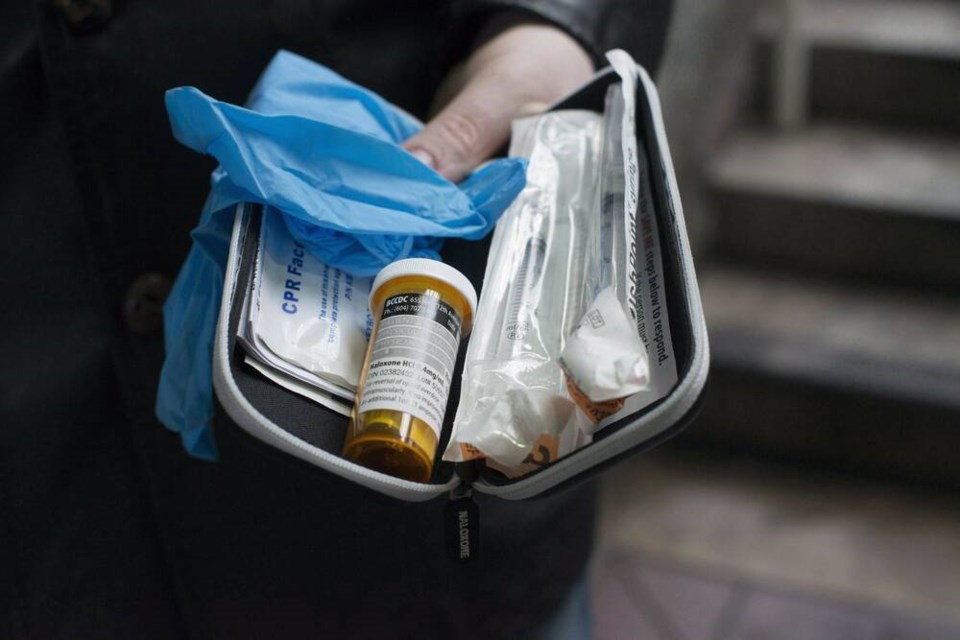B.C. and Alberta have different approaches to the toxic drug crisis, but share one thing in common — they are both losing the battle to deal with it.
There are monthly blips in the overdose death rate. B.C. claimed some progress before the pandemic hit and intensified the crisis. Alberta lately has been citing some success. But over the last several years, opioid toxicity has rampaged past the two provinces’ different approaches to curbing it.
Although there are commonalities, B.C. is emphasizing harm reduction, which implicitly accepts people will use drugs. So the work is toward safer supply, safe consumption and outright decriminalization of hard drugs for a three-year experiment.
The decriminalization era is only four months old so the evidence is not yet in. But much of the political debate centres on strange new disparities in law. Smoking and drinking beer and wine in some local parks is illegal, but using hard drugs is not.
Most of Alberta’s emphasis is on recovery. The government shut down one safe consumption site and emphatically rejected any thought of decriminalization. Harm reduction is in play, but there is far more stress on recovery.
An independent academic analysis of the toxic drug crisis in western Canada published by Stanford University trawls through national and provincial statistics and concludes that B.C.’s drug mortality is now as high as the worst affected areas on the U.S.
Declaring it a public health emergency in 2016 made little difference. The death rate as of December 2022 was more than twice the rate when the emergency was declared, the report from the Stanford Network on Addiction Policy said.
B.C.’s problem is much worse than Alberta’s, but that province is not far behind in per capita deaths.
The report, released in March, says enforcement against drug crime has dropped across Canada in recent years, with the volume of sentencing down by more than 50 per cent.
The majority of reported opioid offences in Canada occur in B.C. — nearly half the national total. The rate of opioid-related police-record incidents in 2021 was four times that of Alberta’s, it said.
“Despite the high volume of drug violations in B.C. criminal charges are low and appear disconnected from incident rates. By contrast, charges for serious drug-related crimes are much higher in Alberta.”
It calls B.C. the “epicentre” of drug crime. It cited 57 opioid-related police reports per 1,000 population, compared to 13 in Alberta.
“In B.C. drug possession incidents have increased significantly in the last decade and trafficking, production and distribution have also increased since 2016. But charges rates for both categories have remained broadly flat or even fallen over the same period, suggesting a lack of interest by law enforcement in the traditional prosecution for these offences.”
The statistics cited confirms police stopped routinely charging people for simple possession in recent years. “However this does not seem to reflect a law enforcement focus on upstream interdiction instead.”
It said Alberta charges far more people for trafficking, production and distribution relative to cases detected.
The key driver of the death rate is fentanyl, which is far more prevalent in the West than the rest of Canada. It was detected in more than 80 per cent of all overdose deaths in both provinces in recent years.
Two of the people involved in the report advised the Alberta government on recovery.
It concluded that it’s too soon to tell if Alberta’s recovery-oriented system is better than B.C.’s more harm reduction centred approach.
“The rate of drug deaths in B.C. has been increasing for two decades, and 2022 only saw a very modest decline, so it’s unclear whether further investment in the same harm reduction efforts will improve this state of affairs.” The biggest impediment to informed debate on the never-ending argument is “the lack of data around long-term treatment outcomes, desistance and recovery.
“This is one area where a set of nationally-agreed definition and counting rules would benefit everyone.”
Just So You Know: In the legislature Wednesday, the opposition cited a B.C. Medical Journal report critical of a supportive housing residence in Kelowna.
While many addicted people felt their needs were being met, many more said they started using again in the facility.
“In all honesty, I never smoked [meth] before I moved here,” one resident said. “What’s the saying? ‘If you sit in a barbershop long enough, eventually you’re going to get a haircut.’ ”
Housing Minister Ravi Kahlon said the report was done during the height of the pandemic, when housing was particularly challenging.
>>> To comment on this article, write a letter to the editor: [email protected]



